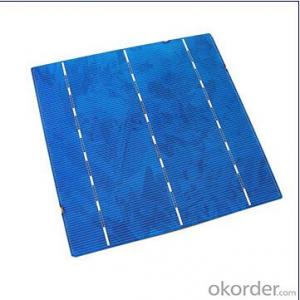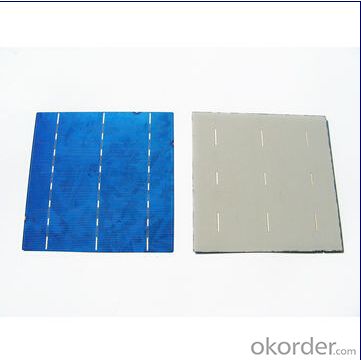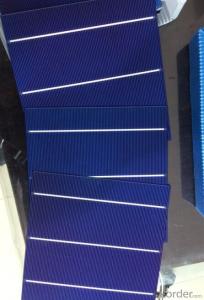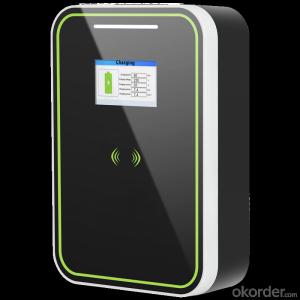Polycrystalline Solar Cell High Quality 17.2% Effy
- Loading Port:
- Shanghai
- Payment Terms:
- TT OR LC
- Min Order Qty:
- 1000 pc
- Supply Capability:
- 100000 pc/month
OKorder Service Pledge
OKorder Financial Service
You Might Also Like
Solar Cells:
Solar cells is made by solar wafer, it has three categories of solar cell right now, monocrystalline polycrystalline and thin film,These cells are entirely based around the concept of PN junction, which is the critical part of solar module, it is the part that can convert the light energy into electricity, the thickness is from 180um to 200um, with even busbars to conduct electricity, textured cell can decrease diffuse reflection; they are often electrically connected and encapsulated as a module. Photovoltaic modules often have a sheet of glass on the front (sun up) side, allowing light to pass while protecting semiconductor wafers from abrasion and impact due to wind-driven debris, rain, hail, etc. Solar cells are also usually connected in series in modules, creating an additive voltage. Connecting cells in parallel will yield a higher current;With high quality and stable quality. Our Cells can greatly improve the performance of Solar Modules.
Solar Cells Advantage:
• High efficiency and stable performance in photovoltaic conversion.
• Advanced diffusion technique ensuring the homogeneity of energy conversion efficiency of the cell.
• Advanced PECVD film forming, providing a dark blue silicon nitride anti-reflection film of homogenous color and attractive appearance.
• High quality metal paste for back surface and electrode, ensuring good conductivity, high pulling strength and ease of soldering.
• High precision patterning using screen printing, ensuring accurate busbar location for ease with automatic soldering a laser cutting.
Features:
High efficiencies up to 16.4%
Proven long term mechanical stability of silicone
Make of highly purified poly silicone
Three bus bars for reduced series resistance and improved module and cell efficiency
Blue anti-reflecting coating ensures improved light absorption and increased efficiency
Acid texturization offers a uniform appearance and virtually invisible crystal structure
Excellent low light behavior for improved energy yield
Specifications
Max power | 4.1W |
Short-circuit current(Isc) | 8.41A |
Imax at 0.5V | 8A |
Open circuit voltage(Voc) | 0.62V |
Size | 156*156mm |
Efficiency | 16.80% |
FAQ
We have organized several common questions for our clients,may help you sincerely:
①What price for each watt?
It depends on the efficiency of the solar cell, quantity, delivery date and payment terms.
②How long can we receive the product after purchase?
In the purchase of product within three working days, We will arrange the factory delivery as soon as possible. The pecific time of receiving is related to the state and position of customers.Commonly 7 to 10 working days can be served.
③Can you provide the peripheral products of the solar panels, such as the battery, controller, and inverter? If so, can you tell me how do they match each other?
Yes, we can, we have two companies for solar region, one is CNBM International, the other is CNBM engineering Co.
We can provide you not only the solar module but also the off grid solar system, we can also provide you service with on grid plant.
④What is your warranty of solar cell?
Our product can promise lower than 0.3% open box crack, we support claim after opening the box if it has crackm color difference or sth, the buyer should give pictures immediately, we can not accept the claim after the solar cell has assembled to solar panel.
• Timeliness of delivery
• ⑤How do you pack your products?
We have rich experience on how to pack the solar cell to make sure the safety on shipment, we could use wooden box or pallet as buyer's preference.
- Q:Can solar cells be used in disaster relief or emergency response situations?
- Yes, solar cells can be used in disaster relief or emergency response situations. Solar cells provide a reliable and renewable source of energy that can be used to power critical devices and infrastructure such as communication systems, medical equipment, lighting, and water purification systems. They are easily deployable, independent of the electrical grid, and can operate in remote areas, making them ideal for emergency situations where access to traditional power sources may be disrupted.
- Q:Is that true that the price of solar cells will be reduced in the coming year?
- There are some policy change from the central government that financial subsidies of purchasing solar cells from the government will be lowered compared to last year. This could be a big reason for the price going down.
- Q:What is a thin-film solar cell?
- A thin-film solar cell is a type of solar cell that is made by depositing one or more thin layers of photovoltaic material onto a substrate. These cells are typically flexible, lightweight, and have a lower manufacturing cost compared to traditional silicon-based solar cells. They can be used in a variety of applications, such as solar panels for buildings, portable electronic devices, and even integrated into clothing or other surfaces.
- Q:Where can I buy solar cells?
- Never bought anything like that.
- Q:How much land is required to install solar cells?
- The amount of land required to install solar cells depends on various factors such as the capacity of the solar system, efficiency of the solar panels, and the power generation goals. On average, it is estimated that a 1 MW solar power plant requires about 4-5 acres of land. However, with advancements in solar technology, the land requirements are decreasing as solar panels become more efficient and produce more power per square foot.
- Q:Can solar cells be used on wearable technology?
- Yes, solar cells can be used on wearable technology. Advances in technology have made it possible to integrate small, flexible, and lightweight solar cells into wearable devices such as smartwatches, fitness trackers, and even clothing. These solar cells can convert sunlight into electricity, providing a sustainable and convenient way to power wearable technology.
- Q:Can solar cells be used for powering schools?
- Yes, solar cells can be used for powering schools. Solar panels can be installed on rooftops or in open spaces near the school to capture sunlight and convert it into electricity. This renewable energy source can help meet the energy needs of schools, reducing their reliance on fossil fuels and lowering their carbon footprint. Additionally, solar power can provide a reliable and cost-effective source of electricity for schools, allowing them to save on energy expenses in the long run.
- Q:Can solar cells be used in powering electric boats?
- Yes, solar cells can be used to power electric boats. Solar panels can be installed on the boat's surface to capture sunlight and convert it into electricity. This clean and renewable energy source can charge the boat's batteries and power the electric motor, allowing for eco-friendly and sustainable boating.
- Q:Can solar cells be used for desalination?
- Yes, solar cells can be used for desalination. Solar energy can be harnessed by solar cells to power desalination plants that convert seawater or brackish water into freshwater through processes like reverse osmosis or multi-stage flash distillation. This sustainable approach reduces reliance on traditional energy sources and offers a potential solution to address the global water scarcity issue.
- Q:How do solar cells perform in different climates?
- Solar cells perform differently in different climates due to variations in sunlight intensity, temperature, and weather conditions. In regions with abundant sunlight and cooler temperatures, solar cells tend to perform optimally, generating higher electricity outputs. However, extreme climates such as very hot or very cold environments can affect the efficiency and lifespan of solar cells. Additionally, cloudy or rainy climates may reduce the overall energy production of solar cells. Despite these variations, solar power remains a viable and increasingly popular renewable energy option in a wide range of climates.
1. Manufacturer Overview |
|
|---|---|
| Location | |
| Year Established | |
| Annual Output Value | |
| Main Markets | |
| Company Certifications | |
2. Manufacturer Certificates |
|
|---|---|
| a) Certification Name | |
| Range | |
| Reference | |
| Validity Period | |
3. Manufacturer Capability |
|
|---|---|
| a)Trade Capacity | |
| Nearest Port | |
| Export Percentage | |
| No.of Employees in Trade Department | |
| Language Spoken: | |
| b)Factory Information | |
| Factory Size: | |
| No. of Production Lines | |
| Contract Manufacturing | |
| Product Price Range | |
Send your message to us
Polycrystalline Solar Cell High Quality 17.2% Effy
- Loading Port:
- Shanghai
- Payment Terms:
- TT OR LC
- Min Order Qty:
- 1000 pc
- Supply Capability:
- 100000 pc/month
OKorder Service Pledge
OKorder Financial Service
Similar products
New products
Hot products
Hot Searches
Related keywords
































